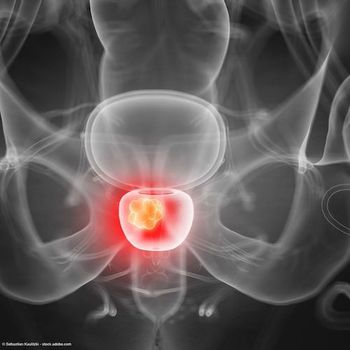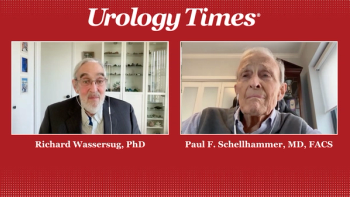
Adding short-term ADT to dose-escalated RT does not improve survival in prostate cancer
The addition of STAD did, however, improve secondary end points, including metastases rates, prostate cancer-specific mortality, and PSA failure.
Findings from the phase 3 NRG Oncology/Radiation Therapy Oncology Group (RTOG) 0815 study (NCT00936390) showed that adding short-term androgen deprivation (STAD) to dose-escalated radiotherapy did not improve overall survival (OS) in patients with intermediate-risk prostate cancer; however, the addition of STAD did improve secondary end points, including metastases rates, prostate cancer-specific mortality, and PSA failure.1
The 5-year and 8-year OS rates for patients receiving radiotherapy alone (arm 1) were 90% and 79% vs 91% and 84% for those receiving radiotherapy plus androgen deprivation in arm 2 (Hazard ratio [HR], 0.85; 95% CI, 0.65-1.11; P = .22; adjusted HR, 0.84; 95% CI, 0.65-1.10). Additionally, 10 patients died of prostate cancer in arm 1 vs 1 patient in arm 2 (cause-specific HR, 0.10; 95% CI, 0.01-0.80; P = .007).
The 5-year and 8-year cumulative distant metastasis incidence rate in arm 1 and arm 2, respectively, were 3.1% and 4.3% vs 0.6% and 1.0% (HR, 0.25; 95% CI, 0.11-0.57; P <.001). The 5-year and 8-year PSA failure rates in each respective arm were 14% and 21% vs 8% and 10% (HR, 0.52; 95% CI, 0.39-0.70; P <.001). Additionally, the 5-year and 8-year salvage androgen deprivation therapy reception rates were 6.1% and 9.8% vs 4.2% and 5.8% in each respective arm (HR, 0.62; 95% CI, 0.41-0.95; P = .025).
Investigators reported no significant differences in non-prostate cancer-specific mortality between arms 1 and 2 (HR, 0.92; 95% CI, 0.70-1.21; P = .56). The 5-year and 8-year local recurrence rates in arms 1 and 2, respectively, were 2.6% and 3.9% vs 0.6% and 2.0% (HR, 0.44; 95% CI, 0.22-0.90; P = .021). Additionally, the 5-year and 8-year combined rates of clinical or biochemical failure were 14.8% and 22.5% vs 7.9% and 11.4% in each respective arm (HR, 0.52; 95% CI, 0.39-0.70; P <.001).
“While there is an initial decline in the hormone and sexual quality of life for [patients who] received short-term hormones in addition to radiation, it is reassuring that this impact was temporary and that quality-of-life outcomes were not clinically meaningfully different between arms by one year,” study author Benjamin Movsas, MD, medical director of the Henry Ford Health Center, said in a press release on patient-reported outcomes (PROs) in the NRG RTOG 0815 study.2 “[PROs] such as these are incredibly valuable to help individuals make informed decisions when determining their treatment options.”
Investigators of the phase 3 NRG RTOG 0815 study assessed the addition of STAD therapy to radiotherapy for patients with intermediate-risk prostate cancer. Radiotherapy modalities included external-beam radiation alone at 79.2 Gy or 45 Gy with brachytherapy boost. In arm 2, patients also received a luteinizing hormone-releasing hormone agonists or antagonists plus antiandrogen for 6 months beginning 8 weeks before radiotherapy.
The primary end point was OS. Secondary end points included prostate cancer-specific mortality, non-prostate cancer-specific mortality, distant metastases, PSA failure, and incidence of salvage therapy.
Patients who had a diagnosis of intermediate-risk prostate cancer within 6 months of study treatment were eligible for enrollment. Patients also needed to have at least 1 of the following features: stage T2b to T2c disease, a Gleason score of 7, or a pretreatment PSA value above 10 and 20 ng/mL or less.
The study included a total of 1492 patients, 750 of whom received radiotherapy alone and 742 received androgen deprivation plus radiotherapy. Investigators determined that disease characteristics and baseline demographics were comparable between the 2 treatment arms.
In the overall population, most patients were between the ages of 60 and 69 (46%), White (75%), and had a Zubrod performance status of 0 (86%). Additionally, most patients had 1 intermediate-risk factor (67%), received dose-escalated external-beam radiotherapy (89%), and had stage T1 disease (63%).
Multivariate subgroup analyses indicated that STAD therapy plus radiotherapy did not yield superior OS for those with a single intermediate-risk factor, multiple intermediate-risk factors, or a predominant Gleason pattern. Moreover, the addition of STAD yielded improvements in all subgroups for PSA failure and distant metastasis rates except for those who had a Gleason score of 2 to 6.
Acute grade 3 or higher adverse effects (AEs) occurred in 2% of patients in arm 1 and 12% of those in arm 2 (P <.001). The cumulative incidence rates of late grade 3 or higher AEs were 14% and 15% in each respective arm (P = .29).
The rates of late endocrine AEs and neurologic toxicity in arms 1 and 2, respectively, were 3.3% vs 45.0% (P <.001) and 5.3% vs 12.0% (P <.001). Grade 3 sexual or reproductive symptoms occurred in 4.8% and 5.0% of patients in each respective arm.
References
1. Krauss DJ, Karrison T, Martinez AA, et al. Dose-escalated radiotherapy alone or in combination with short-term androgen deprivation for intermediate-risk prostate cancer: results of a phase III multi-institutional trial. J Clin Oncol. Published online April 27, 2023. doi:10.1200/JCO.22.02390
2. Patient-reported outcomes form an NRG Oncology study of androgen deprivation therapy with dose-escalated radiotherapy for intermediate-risk prostate cancer show no clinically meaningful differences in scores at one year post-treatment. News release. NRG Oncology. April 27, 2023. Accessed April 28, 2023.
Newsletter
Stay current with the latest urology news and practice-changing insights — sign up now for the essential updates every urologist needs.




















